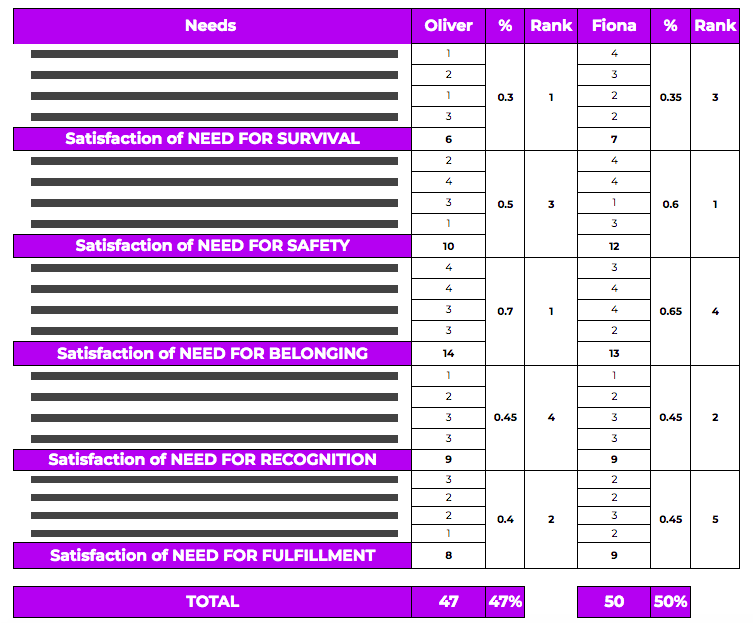It's important that you develop your understanding of work relationships and what motivates individuals. This means identifying the risk factors and causes of conflict.
Become familiar with risk factors
You will gain more insight into the dynamics of a conflict and the related risks if you view conflict as the result of a basic need going partially or completely unfulfilled.
We all have basic needs. There is a stronger likelihood of conflict if they are not appropriately met or are slow or impossible to meet.
Let's analyze your needs and/or those of your team using Maslow’s findings as they pertain to the workplace, broken down into 20 specific needs.
1- The need for survival
The offices are functional, quiet, well-lit, fully equipped and operational, well heated in winter, cool in summer.
The workplace is a reasonable distance from home, with facilities for lunch.
The work schedule allows time for physical recovery, promotes a healthy work-life balance.
Salary is commensurate with the workload and sufficient to meet the worker’s needs.
2- The need for safety
Physical safety on the commute from/to home and at the workplace.
Financial security: regular wages, secure employment, well-managed company.
The feeling of safety in interactions is important: civility, cooperation, respect for privacy.
Projects can reasonably be accomplished, as assessed using SMART goals: specific, measurable, attainable, relevant, and time-based.
3- The need for belonging
Regular constructive feedback.
Internal codes, behaviors, and values are explicit, understood, validated, and internalized.
Included in internal information mailing lists.
Regular invitations to meetings and internal events.
4- The need for recognition, to be esteemed
Work contribution is acknowledged by the team, applauded by superiors.
Making use of one’s skills and suggestions.
Personal identity is respected: self-image, political sensitivity, ethnic origin, cultural/religious beliefs, gender, age, disability/health, sexual orientation, etc.
Self expression is in harmony with the customs and values of the group.
5- The need for fulfillment, self-actualization
Work is stimulating, independent, offers a variety of tasks, and/or is scalable.
Tasks allow for skill improvement and self-expression.
Projects are assigned with some consideration for personal values.
Internal training offers opportunities for skill acquisition and improvement.
Track indicators over time
Calculate satisfaction scores
To calculate the risks of conflict in your company, define and track a satisfaction indicator:
Rank the priority in satisfying each major need, for example: 1- survival, 2- security, 3- recognition, 4- fulfillment, 5- belonging. You can also consider several needs to be equally important and, for example, rank both survival and belonging as 1. This can also change over time due generational differences.
Rank each specific need on a scale from 1 to 5 (where 1 is very unsatisfactory, and 5 very satisfactory).
Track whether this satisfaction has improved or decreased over time.
Here is what that looks like.

Track changes in these scores
The level of individual and team/project satisfaction can be monitored by informal (small talk) and formal means (surveys, one-on-one interviews, yearly evaluations, etc.). Indicators and reporting help identify where there is a risk of conflict. They also help identify competing needs:
Competition is internal when satisfying a need keeps him/her from realizing another. For example, reaching self-actualization through travel versus the need for safety through a sedentary family life.
Competition is external when satisfying one person’s need prevents another from satisfying theirs. For example, if one co-worker gets a promotion and higher esteem, another co-worker doesn't.
Example of a reporting table
Let’s look again at one of the cases from the previous chapters: Case 1. Oliver had a confrontation with Fiona, the company’s logistics manager. In the Needs Satisfaction Reporting Table below, you can see that:
Oliver’s ranking, in order, is the need for belonging first, then self-actualization and then safety, for which he estimates satisfaction levels of 70%, 40%, and 50%, respectively. These levels are relatively good, except for self-actualization where improvements could be made. For example, through more stimulating training and, eventually, a promotion to manage a larger store.
Meanwhile, Fiona's ranking is, in order, safety, recognition, and survival, which she considers 60%, 45%, and 55% satisfied, respectively. Better satisfaction levels for recognition should be a priority for her in the short term. There are two possible sources for this information: her regular collaborators, internal and external, and her higher-ups.

Here is the template ready for you to use, which includes all of the specific needs.
Whether you are implementing a reporting method, or analyzing these elements during a conflict, it is important to understand your own needs and those of the people you are speaking with.
Let's recap!
To complete your conflict analysis, you need to identify the risk factors in your work/team environment. Keep in mind that when a basic need is completely or insufficiently satisfied for some time or there is competition between different needs, then the risk of conflict increases significantly.
By analyzing the 20 specific needs developed based on Maslow’s pyramid, you can evaluate how well needs are being satisfied and track how this evolves over time.
In this first part, we have seen how analyze an emerging conflict. Try your hand at the quiz now to see if there is anything you need to review, and I'll see you in the next part about particular skills needed to resolve the conflict!
